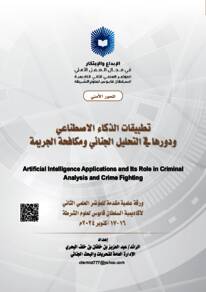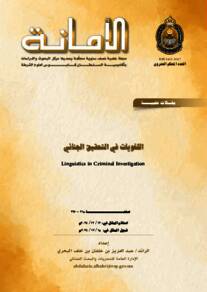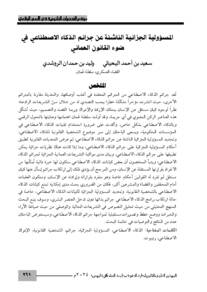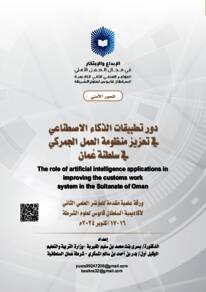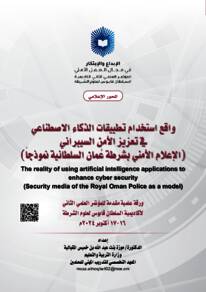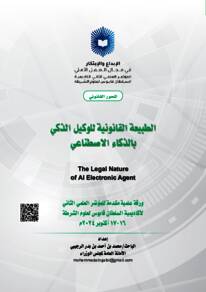Document
تطبيقات الذكاء الاصطناعي ودورها في التحليل الجنائي ومكافحة الجريمة.
Source
الأمانة. ع. 44. ص. 55-73.
Contributors
Other titles
Artificial intelligence applications and its role in criminal analysis and crime fighting.
Country
عمان.
City
نزوى
Publisher
أكاديمية السلطان قابوس لعلوم الشرطة
Gregorian
2024-10-16
Language
Arabic
Subject
English abstract
This study aimed to identify applications of artificial intelligence used by security services in countries around the world and their role in combating crime and criminal analysis, and to identify the challenges facing these applications in criminal investigation. The study relied on the descriptive analytical approach to reach the results.
By reviewing and analyzing research and published articles, the study reached a set of results, the most important of which are that artificial intelligence has been able to help police agencies in pre-predicting crime and combating it, and to contribute positively to the field of technical investigation, such as recognizing facial features and analyzing vital data that helped determine people’s identity faster, and in multimedia analysis. In addition to the ability of 3D printing to improve forensic work, such as reconstructing the skeletons of bodies and the faces of suspects, in addition to reconstructing crime scenes and printing physical evidence.
In light of the study’s results, the researcher recommended finding a comprehensive and clear strategy to benefit from the applications of artificial intelligence in the security and judicial fields in general, to develop national capabilities in this field through continuous qualification and training, and to support specialized research in this field, in addition to updating laws and regulations to create an integrated legal framework for the use of artificial intelligence techniques, and to analyze data to reveal crimes and their prediction, employing artificial intelligence techniques in criminal investigation, and benefiting from international experiences in this field.
Description
المؤتمر العلمي الثاني لأكاديمية السلطان قابوس لعلوم الشرطة: 16-17 أكتوبر، 2024.
ISSN
2412-8317
Hijri
1446
Arabic abstract
هدفت هذه الدراسة إلى الوقوف على تطبيقات الذكاء الاصطناعي التي تستخدمها الأجهزة الأمنية في دول العالم ودورها في مكافحة الجريمة والتحليل الجنائي، والتعرفّ على التحديات التي تواجه هذه التطبيقات في مجال التحقيق الجنائي. وقد اعتمدت الدراسة على المنهج الوصفي للتوصل إلى النتائج.
ومن خلال الاطلاع على البحوث، والمقالات المنشورة وتحليلها توصلت الدراسة إلى مجموعة من النتائج أهمها: قدرة الذكاء الاصطناعي على مساعدة أجهزة الشرطة في التنبؤ المسبق بالجريمة، ومكافحتها، والمساهمة الإيجابية في مجال التحقيق الفني كالتعرف على ملامح الوجه، وتحليل البيانات الحيوية التي ساعدت على تحديد هوية الأشخاص بشكل أسرع، وفي تحليل الوسائط المتعددة. بالإضافة إلى قدرة الطباعة ثلاثية الأبعاد في تجويد العمل الجنائي، كإعادة بناء هياكل الجثث، ووجوه المشتبه بهم، بالإضافة إلى إعادة بناء مسرح الجريمة، وطباعة الأدلة المادية.
وفي ضوء نتائج الدراسة أوصى الباحث بضرورة إيجاد استراتيجية شاملة وواضحة؛ للاستفادة من تطبيقات الذكاء الاصطناعي في المجالين الأمني والقضائي بشكل عام، وتطوير القدرات الوطنية في هذا المجال من خلال التأهيل والتدريب المستمر، ودعم البحوث المتخصصة في هذا المجال، إضافة إلى تحديث القوانين، والأنظمة لإيجاد إطار قانوني متكامل لاستخدام تقنيات الذكاء الاصطناعي، وتحليل البيانات للكشف عن الجرائم والتنبؤ بها، وتوظيف تقنيات الذكاء الاصطناعي في التحقيق الجنائي، والاستفادة من التجارب الدولية في هذا المجال.
ومن خلال الاطلاع على البحوث، والمقالات المنشورة وتحليلها توصلت الدراسة إلى مجموعة من النتائج أهمها: قدرة الذكاء الاصطناعي على مساعدة أجهزة الشرطة في التنبؤ المسبق بالجريمة، ومكافحتها، والمساهمة الإيجابية في مجال التحقيق الفني كالتعرف على ملامح الوجه، وتحليل البيانات الحيوية التي ساعدت على تحديد هوية الأشخاص بشكل أسرع، وفي تحليل الوسائط المتعددة. بالإضافة إلى قدرة الطباعة ثلاثية الأبعاد في تجويد العمل الجنائي، كإعادة بناء هياكل الجثث، ووجوه المشتبه بهم، بالإضافة إلى إعادة بناء مسرح الجريمة، وطباعة الأدلة المادية.
وفي ضوء نتائج الدراسة أوصى الباحث بضرورة إيجاد استراتيجية شاملة وواضحة؛ للاستفادة من تطبيقات الذكاء الاصطناعي في المجالين الأمني والقضائي بشكل عام، وتطوير القدرات الوطنية في هذا المجال من خلال التأهيل والتدريب المستمر، ودعم البحوث المتخصصة في هذا المجال، إضافة إلى تحديث القوانين، والأنظمة لإيجاد إطار قانوني متكامل لاستخدام تقنيات الذكاء الاصطناعي، وتحليل البيانات للكشف عن الجرائم والتنبؤ بها، وتوظيف تقنيات الذكاء الاصطناعي في التحقيق الجنائي، والاستفادة من التجارب الدولية في هذا المجال.
Category
Journal articles

